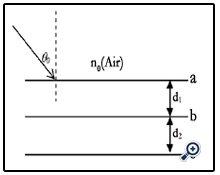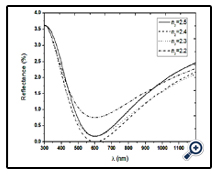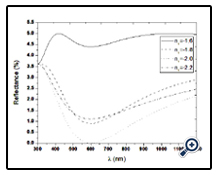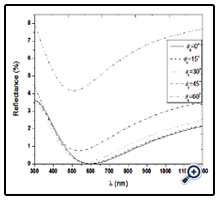Efficiency Enhancement of Solar Cell Using Metamaterials
Dena M. El-Amassi1, Hala J. El-Khozondar2*, Mohammed M. Shabat3
1 Research Assistant, Islamic University of Gaza, Gaza, Palestine.
2 Electrical Engineering department, Islamic University of Gaza, Gaza, Palestine.
3 Physics Department, Islamic University of Gaza, Gaza, Palestine.
*Corresponding Author
Hala J. El-Khozondar,
Electrical Engineering department,
Islamic University of Gaza, Gaza,
Palestine.
E-mail: hkhozondar@iugaza.edu
Article Type: Research Article
Received: April 28, 2015; Accepted: June 10, 2015; Published: June 11, 2015
Citation: Dena M. El-Amassi, Hala J. El-Khozondar, Mohammed M. Shabat (2015) Efficiency Enhancement of Solar Cell Using Metamaterials. Int J Nano Stud Technol. 4(2), 84-87. doi: dx.doi.org/10.19070/2167-8685-1500016
Copyright: Hala J. El-Khozondar© 2015 This is an open-access article distributed under the terms of the Creative Commons Attribution License, which permits unrestricted use, distribution and reproduction in any medium, provided the original author and source are credited.
Abstract
In this work, Photovoltaic (PV) cell model with high absorption efficiency is introduced. The proposed four layer PV cell model consists of antireflection coating (ARC) layer on glass based and covered by metamaterial (MTM) bounded by air. The effect of the refractive index of MTM as well as the effect of the incident angle on the reflectance are considered. Results showed that the reflectance of the PV can be controlled by changing the reflectance index of MTM as well changing the incident angle.
2.Introduction
3.Proposed Solar Cell (PV)
4.Results and Discussion
5.Conclusion
6.References
Key Words
Antireflection coating (ARC); Metamaterials; Solar Cell; Optimization; Reflectance; PV efficiency.
Introduction
Renewable energy known as environmentally friendly attracted a lot of attention due to the energy crises especially in the third world. Solar energy is the most promising among other sources of renewable energy because of its abundance in nature and cleanness. The main component in the system is the PV cell. For a PV cell to work appropriately its absorption to sun light must be optimized. Different works have been establish to reach the optimal values for light absorption by PV cell with maintaining reasonable cost of the cell.
These studies focused in using antireflection coating (ARC) to improve the internal structure of the PV cell [1]. The simplest structure is achieved by using a single ARC on a substrate. Different materials are used for ARC as in [2-5]. SiNx is the mostly used as ARC because it has high refractive index value that can varied by changing deposition paramters [6]. A more complex PV cell that lead to mimimum reflecance at wider range of wavelengths is achieved by using double ARC with different materials. Examples of double layer ACR is found in [6-9]. Beye [10] proposed a double ARC solar cell with same materials of SiNx.
In his work, the minimum reflectance is achieved below 5%. In this work, we poposed a solar cell waveguide structure model with even lower reflectance that reach as low as 1% using double layer one of them is ARC and the other is metamaterial (MTM). Metamaterial is a noval material fabracted at laboratory with negative refractive index. They assume different refractive index by changing certain parameter as in [11, 12]. Next section is dedicated to introuce the proposed PV cell. Section 3 presents the results and discusion. Finally, the conclusion is given in section 4.
Proposed Solar Cell (PV)
Figure 1 exhibits the structure of the proposed solar cell. In the structure, the PV cell consists of SiNx thin film deposited on glass and covered by MTMs bounded by air. The refractive indices as denoted in Figure 1 are n0, n1, n2, and ns for air, MTMs, SiNx and glass respectively. MTM layer thickness is d1 while the film thickness is d2. The light is assumed to shine on the PV at oblique incidence with different incidence angle (θ0).
For oblique incidence, the optical admittance for the kth layer including negative index materials is derived in the paper of [13, 14] for both transverse electric field polarization (TE) and transvers magnetic field polarization (TM) as follows:
Where θk is related to θ0 by Snell's law
The 2x2 transfer matrix that relates the field components at two successive boundaries (e.g. a and b) is defined as follows:
where δk = 2πnkdkθk / λ is the phase difference. For m layers, the overall transfer matrix (MT) is defined in terms of individual matrix as follows:
Then the reflectance can be derived from equation (5) and (6). The reflectance R =|r|² where r is the reflection coefficient defined as:
Following [13, 14], the reflectance for our system is derived for both TE and TM polarization as follows.
For TE the reflectance RTE is
and for TM the RTM is
The total reflectance R for the solar cell is defined as the average of both values RTE and RTM :
The Total reflectance (equation (10)) is solved using the software Maple 13 to verify the characteristics of the proposed PV cell.
Results and Discussion
The structure under consideration has film consisting of SiNx on glass substrate with ns=1.47, and covered by negative refractive index MTM bonded from above by air with n0=1. The thicknesses d1 and d2 are taken to be equal the quarter wavelength at each media (dm=λm/4), where λm = λ/nm and nm is the refractive index for each media. Usually the wavelength λ is chosen close to the peak of the solar spectrum (λ=600nm). The spectral response of SiNx goes from 300-1200nm [10]. Thus, this range is taken to limit the spectrum of the incident light. In our calculation, we consider first normal incidence with n1=-2 and vary n2 to achieve optimal value of n2 at which the reflectance equals zero. Figure 2 exhibits the total reflectance R as calculated from equation (10) using Maple 13. In the calculation, we let n2 assume the followingvalues: 2.5, 2.4, 2.3, and 2.2 as indicated in Figure 2. We noticethat the spectral takes zero value when n2=2.4 and all other curves maintain a reflectance lower than 1%. Comparing our result with one or two ARC layers in Beye calculations [10], we obtain a better result since his system maintained reflectance fewer than 5%.
To further check the optimal structure, we let n2=2.4 and vary n1 as in Figure 3. We realize that the optimal value of n1=-2.Moreover, with excluding n1=-1.6, we found that reflectance at 600 nm below 1.5% which lower than the values obtained by [10].
Figure 4 displays the results for the proposed PV cell at n2=2.4 and n1=-2 with oblique incidence. We notice that for low angles (θ0=0°,15°,30° and 45°) the reflectance is below 4.5% almost in the whole spectrum and for θ0=60° the reflectance is below 8% for the whole spectrum. These results are better than the result obtained by Beye [10].
Conclusion
In this work, we proposed double layer PV cell with different materials where one layer consists of MTM and the other is ARC made of SiNx. The double layers are bounded from below by glass and coved by air. The average reflectance is numerically solved using maple 13. The numerical calculations are obtained under different condition; by varying the MTM parameters, or varying SiNx refractive index, or at different incident angles. Results show that the average reflectance reached its minimum when n1=-2, n2=2.4 and for normal incidence. Moreover, the average reflectance under different conditions low compared to other proposed structures. The results are useful to improve the efficiency of PV cell.
References
- Rancourt JD (1996) Optical thin films: User's handbook, Washington:SPIE Optical Engineering Press.
- Bouhafs D, Moussi A, Chikouche A, Ruiz JM (1998) Design and simulation of antireflection coating systems for optoelectronic devices: Application to silicon solar cells. Solar Energy Materials and Solar Cells 52: 79-93.
- Barshilia HC, Selvakumar N, Rajam KS (2006) TiAIN/TiAlON/Si3N4 tandem absorber for high temperatute solar selective applications, Appl. Phys.Lett., 89: 191909-3.
- Lee HC, Su YK, Chuang WK, Lin JC, Huang KC et.al, (2010) Discussion on electrical characteristics of i-In0.13Ga0.87N p-i-n photovoltaics by using a single/multi-antireflection layer. Solar Energy Materials and Solar Cells 94(7):1259-1262.
- Sopori B (2005) Dielectric films for Si solar cell applications.J. Electron Mater 34: 564-570.
- Lee Y, Gong D, Balaji N, Lee Y, Yi J (2012) Stability of SiNx/SiNx double stack antireflection coating for single crystalline silicon solar cells. Nanoscale Res. Lett. 7: 50-56.
- Alemu A, Freundlich A, Badi N, Boney C, Bensaoula A (2010) Low temperature deposited boron nitride thin films for a robust antireflection coating of solar cells. Solar Energy Mater, Solar Cells. 94(5): 921-923.
- Taguchi H, Soga T, Jimbo T (2003) Fabrication of GaAs/Si tandem solar cell by epitaxial lift-off technique. Japanese Journal of Applied Physics Part 2-letters 42 L1419-1421.
- Valdivia E, Desfonds E, Masson D, Fafard S, Carlson A et.al (2008) Optimization of antireflection coating design for multi-junction solar cells and concentrator systems.Proceedings of the society of Photo-Optical Instrumentation Engineers 7099.
- Beye M, Faye ME, Ndiaye A, Ndiaye F, Maiga AS (2013) Optimization of SiNx Single and Double Layer ARC for Silicon Thin Film Solar Cells on Glass. Research Journal of Applied Sciences, Engineering and Technology 6(3): 412-416.
- El-Khozondar HJ, El-Khozondar RF, Zouhdi S (2015) Tunable MTMs consists of a single-walled nanotube thin film waveguide covered by nonlinear cladding.Applied Physics A 119: 451-453.
- Werner DH, Kwon D, Khoo I, Kildishev AV, Shalaev VM (2011) Liquid crystal clad near-infrared metamaterials with tunable negative-zero positive refractive indices. Optics Express 15(6): 3342-3347.
- Al-Turk S (2011) Analytic optimization modeling of anti-reflection coating for solar cells, Master thesis, MacMaster University: Open Dissertations and theses.
- Lequime M, Gralak B, Guenneau S, Zerrad M, Amra C (2013) Optical properties of multilayer optics including negative index materials. Physics- Optics 1-9.









